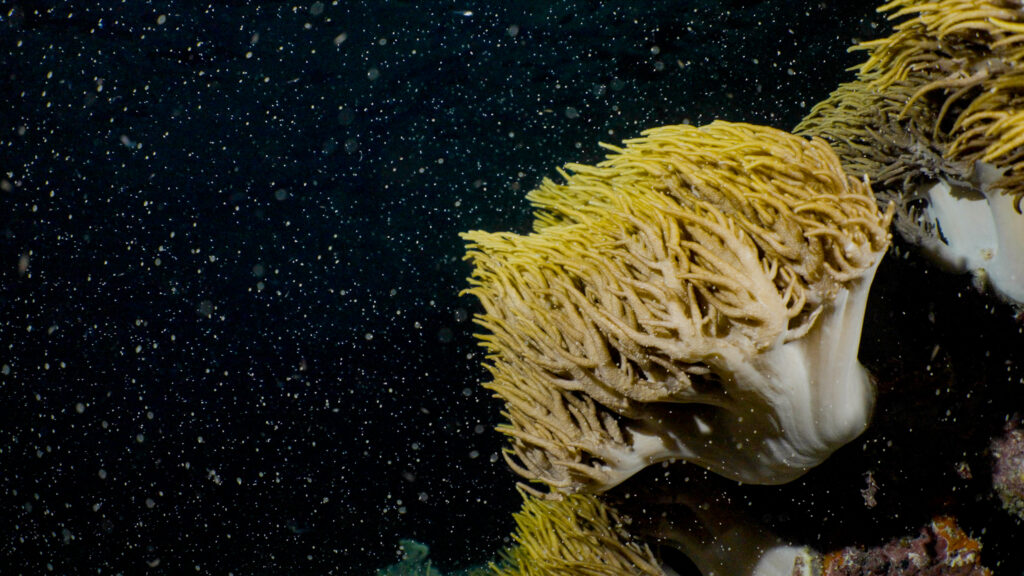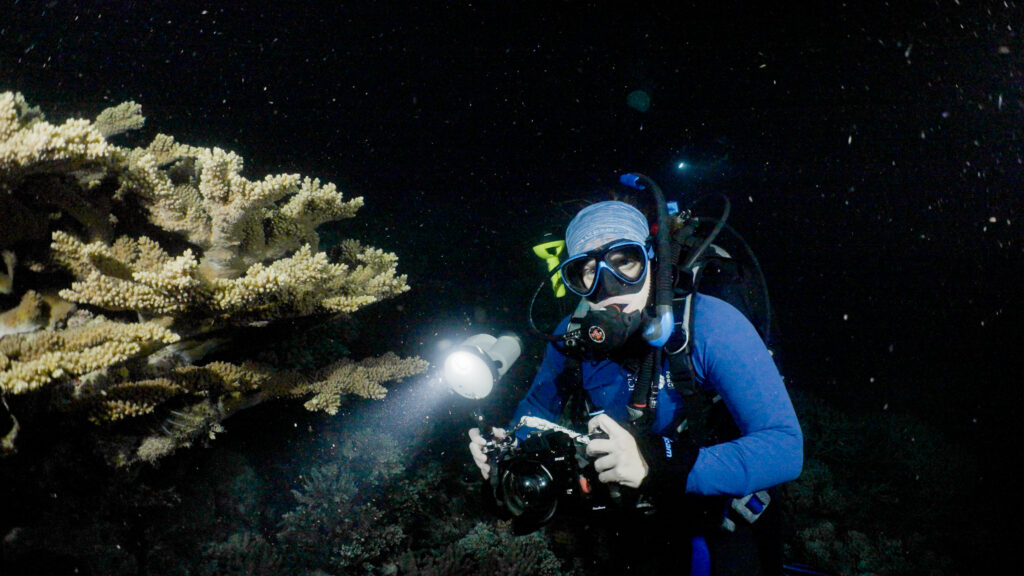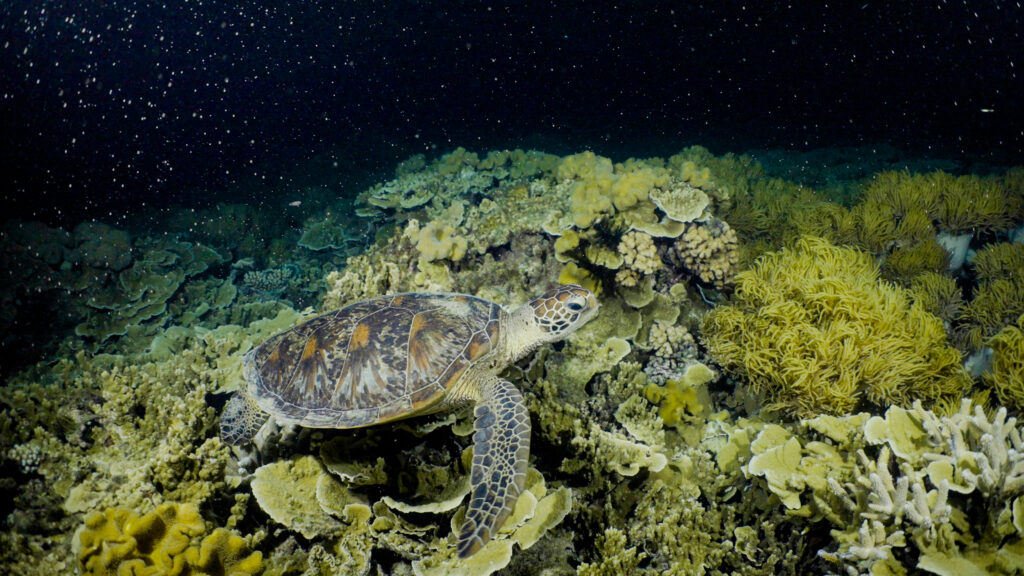
Vidéo : La nouvelle génération de coraux « explose » dans la Grande Barrière de Corail
Des milliards de minuscules boules roses ont explosé dans l’eau au-dessus de la Grande Barrière de Corail, alors que différentes espèces de coraux mous et une poignée de coraux durs entamaient leur processus de régénération annuel.
Les chercheurs analysent la prochaine génération de coraux sur la Grande Barrière de Corail après que le début de la ponte annuelle des coraux ait été enregistré la semaine dernière (2 novembre 2023) sur Moore Reef, à 47 km à l’est de Cairns.
Les faisceaux de cellules sexuelles sur le récif s'ouvrent, libérant des spermatozoïdes et des œufs qui se heurtent alors qu'ils flottent sur les courants marins coralliens, puis se déposent sur les décombres coralliens pour former des bébés coraux.
Le biologiste marin Stuart Ireland filme la renaissance annuelle de la Grande Barrière de corail depuis 1996, et l'événement de 2023 est la dixième fois qu'il le documente depuis le ponton de Sunlover Reef Cruises à Moore Reef.
« La couverture corallienne et la diversité sont très élevées à Moore Reef après les six dernières années de forte croissance, et la ponte de 2023 le reflète », dit-il.
« Comme les années précédentes, nous avons observé les coraux mous commencer le processus de frai et avons passé quelques heures à observer les paquets de spermatozoïdes et d'œufs libérés. Nous plongerons à nouveau sur Moore Reef après le coucher du soleil ce soir et nous espérons voir le phénomène encore plus spectaculaire des coraux durs entamer le processus de régénération sur la Grande Barrière de Corail.
L'Irlande a été rejointe par le Dr Abbi Scott, coordinateur du centre récifal de Cairns-Port Douglas , chercheur au Centre de recherche sur les eaux tropicales et les écosystèmes aquatiques (TropWater) de l'Université James Cook, qui travaille avec des voyagistes pour comprendre le recrutement des coraux après l'événement de frai.

Le Dr Scott explique que des tuiles ont été déployées sur cinq récifs et que les bébés coraux qui y poussent seront analysés l'année prochaine avec les données disponibles pour les modèles de dispersion des larves de coraux afin de mieux comprendre la connectivité des récifs d'où les larves sont originaires.
"Cette recherche permettra d'acquérir des connaissances sur la variation relative du recrutement corallien sur chaque récif étudié et sur la manière dont elle diffère pour chacun de ces récifs", explique le Dr Scott.
"Il sera utile d'éclairer les initiatives de récupération assistée des coraux et d'aider les opérateurs à gérer leurs sites touristiques de grande valeur."
Le réseau Cairns-Port Douglas Reef Hub est une approche communautaire de base en matière de santé des récifs soutenue par les propriétaires traditionnels, les scientifiques, les opérateurs touristiques et la communauté.

Le Dr Abbi Scott, coordinateur du centre récifal de Cairns-Port Douglas, au travail
Financé par le partenariat entre le Reef Trust du gouvernement australien et la Great Barrier Reef Foundation , il rassemble des individus et des organisations qui souhaitent apprendre, partager et collaborer pour tester de nouvelles approches de récupération, de protection et d'adaptation assistées des récifs coralliens qui apportent des avantages à la population locale. les récifs et la communauté face au changement climatique.
L'étude sur le recrutement des coraux n'est que l'un des nombreux projets innovants de réhabilitation et de gestion des coraux en cours dans la région de Cairns et de Port Douglas. John Edmondson, propriétaire de Wavelength Reef Cruises et biologiste marin, a contribué à développer le concept de recherche sur le recrutement.
Le Dr Scott a déclaré que Wavelength était l'un des cinq opérateurs touristiques impliqués dans le projet, avec des tuiles placées sur cinq récifs par Down Under Cruise and Dive, Experience Co, Passions of Paradise, Quicksilver Group, Wavelength et l'organisation à but non lucratif Reef Restoration Foundation, qui gère des pépinières de coraux sous-marines à Moore Reef.

"Une telle étude à l'échelle régionale à travers un réseau d'opérateurs touristiques fournit des données inestimables pour la région de Cairns-Port Douglas et constitue un modèle potentiel pour d'autres points chauds touristiques tels que le tourisme et la recherche.Les arcs deviennent plus entrelacés », dit-elle.
"Les tuiles seront récupérées en février et analysées dans le laboratoire TropWater par le réseau Hub d'opérateurs touristiques, d'organisations non gouvernementales et de propriétaires traditionnels."
Anna Marsden, directrice générale de la Great Barrier Reef Foundation, ajoute : « À l’heure actuelle, la Grande Barrière de Corail regorge d’une nouvelle vie.
« La reproduction annuelle des coraux est non seulement l’un des phénomènes naturels les plus extraordinaires de la planète, mais elle nous offre également l’opportunité d’accélérer la recherche de pointe pour protéger son avenir des impacts du changement climatique. »
Plus de 91 % des récifs étudiés sur la Grande Barrière de corail ont été affectés par le blanchissement des coraux, selon un rapport de 2022 rédigé par des scientifiques gouvernementaux.
Toutes les images sont une gracieuseté de Calypso Productions.
L'article Vidéo : La prochaine génération de coraux « explose » dans la Grande Barrière de Corail apparaît en premier sur Marine Industry News .
